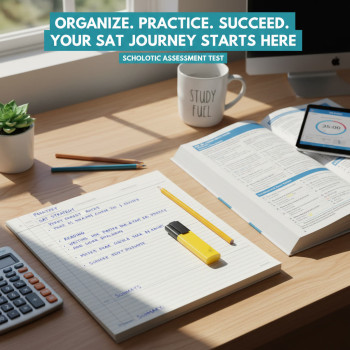Welcome — Why this guide exists (and why it’s actually useful)
If the phrase “Digital SAT” makes your stomach do a little flip, you’re not alone. The SAT has moved from paper and pencil to a digital format, which changes the experience (and some strategies) — but not the goal. Colleges still want to see how you reason, read, and solve problems. This guide walks you through everything a beginner needs: what the digital SAT looks like, how adaptive testing works, realistic study plans, practice tools, test-day logistics, and calming strategies to turn nerves into focus.
Think of this as the one-stop playbook for the next few months. Read it with a highlighter nearby, and circle the parts that feel relevant to you. You don’t have to do everything — just pick the right moves for the score you want and the time you have.
What the Digital SAT is — in plain language
The Digital SAT still measures the same core skills: evidence-based reading and writing, and math. But the way questions are delivered and how you interact with them are different. The entire test is taken on a secure, College Board-approved testing app, and you’ll use a device (either provided in school administrations or your own approved device for some administrations) to complete the exam. The testing environment includes built-in tools like an on-screen calculator and highlighting/annotating features for passages.
Bottom line: your critical thinking and content knowledge matter more than ever. The format aims to be more streamlined and student-friendly — more time per question in many cases, tools built in, and adaptive modules that are meant to better match question difficulty to your level during the exam.
Structure and timing — what to expect
The digital SAT is organized into two main areas: Reading & Writing and Math. Each of those is delivered in shorter digitally adaptive modules rather than one long paper section. Because the test adapts, the exact number of questions you see at each difficulty level can vary, but the total time and the broad content coverage are consistent.
| Section | Content Focus | What changes on digital |
|---|---|---|
| Reading & Writing | Passage comprehension, grammar, evidence-based questions | Shorter modules, on-screen annotation tools, no separate sentence-completion subtest |
| Math | Algebra, problem solving & data analysis, advanced math | Built-in calculator available for the whole math section; question types include multi-select and technology-friendly graphs |
Because of the adaptive design, you’ll typically get a mix of question difficulties. The key shift for students: adaptive tests reward steady accuracy rather than guessing wildly to hit one or two very hard problems.
How adaptive testing works — no mysterious magic
Adaptive testing sounds intimidating, but it’s mostly common sense in a fancy wrapper. The test is divided into modules. How you do in the first module influences the difficulty of the next module. If you do well, the test gives slightly harder questions to better pinpoint your strengths. If you struggle, it gives slightly easier questions to find the right level. Your final score isn’t based on one module alone but on the pattern of responses across the whole exam.
Tips for thinking about adaptation:
- This is not a “gotcha” system — it’s a way to place you at an accurate difficulty level quickly.
- Accuracy matters more than attempting every single question. A wrong answer can drag down your standing in the module; a blank doesn’t help, but smart time management reduces careless errors.
- Consistency across modules is rewarded. If you can maintain your calm and keep doing your best on each cluster of questions, the algorithm will find your appropriate score range.
Tools on the test — what’s available and how to use them
Unlike the old paper SAT, the digital test gives you on-screen tools. Familiarity with these tools can shave minutes off your time and reduce stress.
- On-screen calculator: available in the math portion. Practice using the embedded calculator so you’re fluent with its features.
- Highlighting and annotation: useful for reading passages and complex word problems. Use it to mark evidence or important numbers.
- Flagging questions: you can mark questions to return to. Make a plan for how and when you’ll revisit flagged items.
Practice with these tools in the official Bluebook app or any official digital practice test so the real exam doesn’t come with surprises.
Photo Idea :
Scoring explained — what your score means
Scoring is fundamentally the same in purpose: your score is a summary of how well you demonstrated the tested skills. You’ll still see a composite score (the typical 400–1600 scale) representing Reading & Writing and Math combined, with each area reported on its own scale. Your score report also provides diagnostic information about question types and performance bands — useful for targeted studying.
Don’t obsess over one practice test score. Use multiple practice tests to see trends. Improvement over time is the signal colleges care about most — it shows learning and effort.
Getting started: a practical six-week plan for beginners
Below is a practical, realistic plan if you’re starting from scratch and have six weeks until test day. You can scale up or down depending on how much time you have, but the principles remain the same: assess, target, practice, review, and simulate.
| Week | Focus | Daily Commitment |
|---|---|---|
| 1 | Diagnostic: take a full-length digital practice test in Bluebook | 1–2 hours to take the test; 30–60 minutes to review incorrect answers |
| 2 | Build fundamentals: math topics you missed; grammar rules | 45–90 minutes focusing on weak areas |
| 3 | Targeted practice: question bank drills and pacing practice | 45–90 minutes, include timed sections |
| 4 | Strategy week: passage strategies, calculator fluency, guessing strategies | 60 minutes including practice sets and timing drills |
| 5 | Full-length practice tests + review | 1–3 hours per full test plus deep review sessions |
| 6 | Polish & rest: light practice, review key error patterns, sleep & logistics | 30–60 minutes of light review, early nights |
During the plan, keep a log of mistakes. One of the most powerful habits is writing down the type of mistake (careless, timing, concept) and the fix you’ll commit to next time.
Study techniques that actually work
There are plenty of study tricks, but the ones below have helped thousands of students move the needle.
- Active recall over passive reading: practice retrieval — try to solve problems without looking at solutions, then check and correct.
- Spaced repetition: revisit tricky grammar rules and math formulas in increasing intervals.
- Error analysis: after every practice test, categorize mistakes and make a short plan to fix each category.
- Timed micro-sessions: practice blocks of 20–30 minutes at full focus, then short breaks. This builds stamina and simulates the test-day rhythm.
- Simulate the test environment: use the Bluebook app for at least one full-length practice to experience the adaptive format and on-screen tools.
Common beginner mistakes and how to avoid them
Knowing what trips up beginners can save days of wasted study time.
- Under-practicing with the digital interface — solution: take at least two full-length tests on the official app.
- Ignoring pacing until the last minute — solution: practice short timed sets early and build pacing into daily study.
- Not reviewing errors deeply — solution: spend more time on review than on taking tests; the learning happens in the review.
- Isolating skills without synthesis — solution: periodically take mixed practice sets so you learn to switch gears like on test day.
What to bring and test-day logistics
Short list for the day-of: bring a fully charged approved device if required for your testing administration (and know how the testing app launches), an approved calculator if you prefer a handheld one (check policies on models and features beforehand), a charged backup battery if the rules allow, your admission ticket or ID as required, snacks for before/after, and a calm plan for arrival.
Logistics tip: do a dry run. The night before, confirm travel plans, charge devices, and make a checklist. Sleep is not optional — aim for a solid night of rest.
How practice should feel — moving from confusion to confidence
Early practice often feels unfair: questions seem strange and scoring may not reflect improvement — that’s normal. The pattern to watch for is consistent reduction in repeat errors. If you make the same mistake three times on similar problems, you haven’t learned the lesson yet. If you make a new mistake once in a while, that’s part of growth.
Celebrate small wins: shaving 15 seconds off a math problem, consistently answering a certain type of evidence question correctly, or completing a timed block without panic. These are the building blocks of a bigger score jump.
How personalized tutoring speeds things up (and when it’s worth it)
Independent study is powerful, but the right personalized support can amplify results. One-on-one tutoring helps in three big ways:
- Tailored plans: tutors create a study roadmap focused on your specific weaknesses rather than a one-size-fits-all program.
- Real-time feedback: instant corrections during problem work prevents bad habits from forming and clarifies thinking.
- Motivation and accountability: regular check-ins and realistic milestones keep you on track when motivation dips.
Services like Sparkl offer personalized tutoring with expert tutors, tailored study plans, and AI-driven insights that identify weak patterns quickly. If you’ve tried solo study for a month and feel stuck, targeted tutoring for a short period can deliver efficient gains — think of it as paying to shortcut months of trial-and-error.
Practice resources — what to use and how to use them
Use official practice tests in the Bluebook app to get comfortable with the adaptive format and on-screen tools. Pair full-length practice tests with targeted drills from question banks, and use a tutor or study partner to get feedback on reasoning and explanations.
- Official digital practice tests: simulate test day in Bluebook.
- Student question banks: target weak skills with clustered practice.
- Guided tutoring sessions: use them to fix persistent errors and plan practice.
Example: turning a recurring error into mastery
Scenario: You keep missing reading questions that ask for “evidence for an inference.” You might be picking an answer that sounds plausible without verifying which line in the passage actually supports it.
Step-by-step fix:
- Identify the pattern: tag every wrong reading question in a test as “evidence” or another label.
- Practice targeted pairs: find question pairs where one asks the inference and the other asks for the evidence. Practice linking the two.
- Drill the habit: before selecting an answer for an inference, find the sentence that would prove it and check it matches exactly.
- Simulate under time pressure: practice this approach on timed sets until it becomes automatic.
With targeted feedback — either in a tutoring session or by reviewing answer explanations carefully — this pattern will usually improve quickly.
Mental game: managing stress and pacing on test day
Nerves are normal. Manage them with simple rituals:
- Breathing break: a 60-second breath check after each module to reset focus.
- Mini-plan for difficult questions: if a question looks ugly, flag it, move on, and come back with fresh eyes.
- Positive cue: pick one affirming phrase to say silently during testing (e.g., “One step at a time”).
Remember, adrenaline can help focus for short bursts. Use it to sharpen attention rather than letting it scatter your thoughts.
After the test — evaluating performance and next steps
Once scores are back, don’t panic. Read the score report carefully. Look beyond the single number and examine the sub-scores and question-type data to know what to prioritize next. If you improved, reinforce the habits that got you there. If you didn’t, use targeted tutoring or a short sprint of focused practice to attack the persistent gaps.
Final pep talk — you’ve got this
Preparing for the Digital SAT is as much about mindset as it is about content. The format may have changed, but the skills the test measures — careful reading, logical thinking, and solid math reasoning — are learnable. Make a realistic plan, practice with official digital tools, review mistakes like clues instead of failures, and don’t be afraid to ask for help. A few sessions of personalized tutoring, like Sparkl’s one-on-one plans, can make your study time more efficient and targeted.
Start small, practice steadily, and measure progress honestly. Whether you need a modest improvement or a major jump, the combination of smart practice, realistic pacing, and the right support will get you where you want to go.
Parting checklist
- Take one full official practice test in Bluebook this week.
- Create an error log and review it after every practice.
- Practice with on-screen tools until they feel second nature.
- Consider 1–3 tutoring sessions if progress stalls — targeted feedback speeds up improvement.
- Plan sleep, travel, and device logistics for test day a week before the exam.
Photo Idea :
Good luck — and remember: small, consistent steps beat last-minute panic. Study smart, practice often, and let the test show what you already know.

















No Comments
Leave a comment Cancel